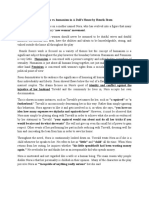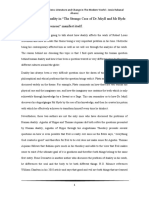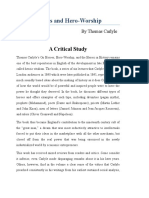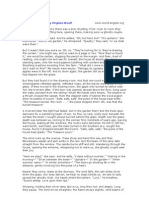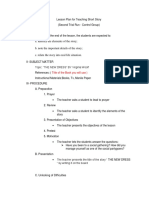0 ratings0% found this document useful (0 votes)
337 viewsNarrative Technique Dalloway
Narrative Technique Dalloway
Uploaded by
Chandrashri ChoudhuryMrs. Dalloway uses a stream of consciousness narrative technique where the story is told from the shifting perspectives of multiple characters throughout a single day. There is no strict chronology or plot, but rather the reader experiences the thoughts, feelings, and perceptions of characters like Clarissa Dalloway and Septimus Smith as they go about their day in post-WWI London. Woolf aims to represent the fragmented inner experiences and psychological effects of the characters rather than an objective truth. She explores how the city environment is differently experienced and interpreted through each character's consciousness.
Copyright:
© All Rights Reserved
Available Formats
Download as DOCX, PDF, TXT or read online from Scribd
Narrative Technique Dalloway
Narrative Technique Dalloway
Uploaded by
Chandrashri Choudhury0 ratings0% found this document useful (0 votes)
337 views7 pagesMrs. Dalloway uses a stream of consciousness narrative technique where the story is told from the shifting perspectives of multiple characters throughout a single day. There is no strict chronology or plot, but rather the reader experiences the thoughts, feelings, and perceptions of characters like Clarissa Dalloway and Septimus Smith as they go about their day in post-WWI London. Woolf aims to represent the fragmented inner experiences and psychological effects of the characters rather than an objective truth. She explores how the city environment is differently experienced and interpreted through each character's consciousness.
Original Description:
Mrs Dalloway and Stream of Consciousness
Copyright
© © All Rights Reserved
Available Formats
DOCX, PDF, TXT or read online from Scribd
Share this document
Did you find this document useful?
Is this content inappropriate?
Mrs. Dalloway uses a stream of consciousness narrative technique where the story is told from the shifting perspectives of multiple characters throughout a single day. There is no strict chronology or plot, but rather the reader experiences the thoughts, feelings, and perceptions of characters like Clarissa Dalloway and Septimus Smith as they go about their day in post-WWI London. Woolf aims to represent the fragmented inner experiences and psychological effects of the characters rather than an objective truth. She explores how the city environment is differently experienced and interpreted through each character's consciousness.
Copyright:
© All Rights Reserved
Available Formats
Download as DOCX, PDF, TXT or read online from Scribd
Download as docx, pdf, or txt
0 ratings0% found this document useful (0 votes)
337 views7 pagesNarrative Technique Dalloway
Narrative Technique Dalloway
Uploaded by
Chandrashri ChoudhuryMrs. Dalloway uses a stream of consciousness narrative technique where the story is told from the shifting perspectives of multiple characters throughout a single day. There is no strict chronology or plot, but rather the reader experiences the thoughts, feelings, and perceptions of characters like Clarissa Dalloway and Septimus Smith as they go about their day in post-WWI London. Woolf aims to represent the fragmented inner experiences and psychological effects of the characters rather than an objective truth. She explores how the city environment is differently experienced and interpreted through each character's consciousness.
Copyright:
© All Rights Reserved
Available Formats
Download as DOCX, PDF, TXT or read online from Scribd
Download as docx, pdf, or txt
You are on page 1of 7
Narrative technique
Mrs. Dalloway, like many modernist novels, such as James
Joyce’s A Portrait of an Artist as a Young Man or Ulysses,
has no definite story or plot line. It begins abruptly in a
morning when Clarissa Dalloway goes to buy flowers for an
evening party she will host. As the day continues the reader is
led without constraint from Clarissa’s stream of consciousness
to Septimus’ to Peter’s and to those of the people they
encounter during the day. The novel undecidedly ends with
the party where all the people that have appeared during the
day are assembled, except for Septimus, since he killed
himself that afternoon, when the doctor came to take him
away to a mental home. He is “present” at the party only in
Doctor Bradshaw’s explanation of why he is so late.
Woolf uses Multiple narrative point of view instead of a
reliable, omniscient narrator, and no chronological ordering of
material. “Epistemological uncertainty” or “everlasting doubt
about knowing” most remarkably differentiates the modernists
from the realists. This is why the omniscient narrator is
replaced by the streams of consciousness of the characters,
which are all interlinked. Mrs. Dalloway’s social image
conceals incompatible aspects of her personality which could
be refracted into divergent and contradictory images. Each of
the other characters sees only one of these incompatible
aspects and takes this to be her total personality. Thus, as the
novel progresses, the early static image in the mirror gives
way to a series of shifting and contradictory views of Mrs.
Dalloway, and her identity expands to encompass all the
divergent images while remaining unencompassed by them.
Woolf’s narrative strategy is to follow the stream of
consciousness of her characters and not what is perceived as
‘truth’, as it was for the realists. Her narrative focus is on how
they observe and how they feel doing so. This technique
allows for consideration and reconsideration, for conjecture
and refutation without any definite conclusion. Through the
use of the stream of consciousness the focalisation shifts and
characters alternate between their subject and object roles.
One of Woolf’s techniques in the stream of consciousness
mode is “to burrow into characters’ pasts in order to unearth
their history”. She calls this process “tunnelling” - revealing
her characters to the readers as split beings who live both in
the past and in the present. Their current thoughts tell the
reader who they are, but their memories of the past reveal how
they came to be who they are and in this way the memories
explain to the reader why the characters are as they are. The
consciousness of a character thus becomes visible in Woolf’s
writing.
Most of the novel centers around Clarissa’s thoughts about the
past, mainly when she is thinking whether she would be with
Peter or with her husband, her rejection of Peter’s proposal of
marriage influencing all his later thoughts and actions. Stream
of consciousness is also used to record Septimus’ thoughts
about death and the war.
As in Joyce’s Portrait, Woolf uses both free indirect discourse
and interior monologue for the stream of consciousness mode,
shifting seamlessly between the two and merging the interior
private time and the exterior public time. The
interconnections are often framed, at their simplest, by a
shared occurrence or spatial environment, such as the
aeroplane, the prime-minister’s car and the chiming of Big
Ben that momentarily draw the attention of disparate figures
in the city streets, but they are also developed through patterns
of common and recurring mental images and phrases that
serve to link even characters who never meet, such as Clarrisa
and the shell-shocked Septimus Smith. This aspect of Woolf’s
narrative technique concerns her use of the setting – the
bustling London milieu.
Woolf makes the London milieu vibrate through the
consciousness of her characters who emotionally respond
differently to the different symbolic elements in this milieu.
Woolf uses the web of consciousness about the milieu as a
means of unifying the plot by intersecting the lives of
Clarissa, Septimus and Peter in that web throughout the day.
As the threads of their lives are woven in and out of the
common London milieu, we see a rich tapestry of life in
London from the point of view of these three disparate
characters.
Intersecting with Clarissa's walk is the journey of the shell-
shocked war veteran Septimus Warren Smith and his Italian
wife, Rezia. The same London milieu appears differently to
Septimus. For example, he reacts differently to the back fire
of a grand passing car which prompts people in the street,
including Clarissa, to believe that it may carry the queen or a
high-ranking government official, because they want
desperately to believe that meaning still exists in tradition and
in the figureheads of England. But for Septimus the grey car
seems threatening to create a scene about to burst into flame.
He has lost faith in the symbols Clarissa and others still cling
to.
Other characters are plotted precisely as they walk - across
Green Park - along Fleet Street. Peter Walsh, Clarissa’s
intimate friend since long before her marriage, casually
meanders through London streets. As he does so, he is more
interested in the “state of the world” than in the physical
trapping of the city. He wonders about the mechanics and
gasoline consumption of cars; he surmises about the lives of
the young soldiers marching past him and is reminded of his
own age. He feels young again. The atmosphere induces him
to act in a carefree manner by following a young lady through
the streets and fantasizing about an encounter with her in his
anonymous identity of “You”.
Another London site of intersection of characters is Regent’s
Park. Different characters respond differently to the park’s
atmosphere. Clarissa seems unaffected by the serenity of the
park, except for a cursory acknowledgment of the “silence;
the mist; the hum; the slow-swimming happy ducks; the
pouched birds waddling”. She is more interested in the social
encounter with her friend, Hugh Whitbread, and what he may
think of her and the hat she is wearing. Hugh’s presence in the
Park reminds her of happier times at Bourton where they
spent considerable time together on the lawns and gardens.
The normal everyday life in Regent’s Park, however, feeds
the injured, shell-shocked Septimus’ psychosis to a point
where he sees everything as a threat to him. He experiences
hallucination of trees being alive and connected to him by
“millions of fibres”; birds singing to him in Greek; a dog
turning into a man; promises of beauty from the smoke of the
sky-writing plane, and ultimately Peter Walsh seeming to take
the form of Septimus’ friend Evans, who was killed in the
war. Septimus is unable to bear the life in London, as he
perceives it, and horrified by the prospect of an isolated
soulless existence controlled by London psychiatrists in
mental asylum, he commits suicide to sacrifice his body rather
than his soul. So it can be said that Septimus is swallowed up
by London.
The chimes of the Big Ben, heard all over London, not only
mark time for all Londoners, but also mark the presence of
authority, the power and glory of the British Empire, keeping
its own standard time. Likewise each of the London
landmarks represents a symbolic value. For example, the
statues of famous generals and leaders in Trafalgar Square
suggest the importance of patriotism to the British way of life.
The solemn and respectful atmosphere of a small crowd
gathered before the Buckingham Palace highlights the
crowd’s consciousness of the importance of the royal house.
However, by introducing certain details such as ‘the Queen’s
old doll’s house’ and the Prince who took after King Edward
but was ‘ever so slimmer’, Woolf diminishes and to some
extent subtly ridicules the royal house and its members. That
the crowd was increased ‘by men without occupation’ adds a
trace of the political. Constant oppositions in the account of
the cityscape also emphasise the political consciousness of the
narrator: ‘thin trees’ are opposed to the sculptures of ‘bronze
heroes’, while the crowd is contrasted with the highly revered
royal house individuals. On the other hand, these feelings are
perceived through the individualised members of the crowd
(Moll Pratt, Sarah Bletchley, Emily Coates, Mr Bowley) and
though minimal, there is some insight into their
consciousness, while the members of the royal family remain
mysterious and are mentioned either by their titles or names
but with no insight into their psychological identities.
In the wailing siren of the ambulance carrying Septimus’s
body, Peter hears all that is good about English society—its
humanity, efficiency, and compassion. However, Septimus
found those same things constricting and deadening, not
liberating and inspiring. Septimus fought to preserve these
virtues during the war, and they eventually became hollow
and meaningless to him. Peter hears humanity in the
ambulance siren, but the inhumanity of the English medical
system played a part in Septimus’s death. So, while to
Clarissa and Peter, London is promising and joyous, it is
nevertheless threatening and devastating for it ‘has swallowed
up many millions of young men called Smith’. By depicting
Septimus’ disintegrating personality, that is, his mindscape,
Woolf depicts the disintegration of post-war London and its
inhabitants. Thus both the external London milieu and its
internal mindscapes in Mrs Dalloway are represented in the
mode of modernist vision as fragmented, chaotic and
disorderly, caused by the disillusioning effect of war
devastations and post-World War I crisis.
Finally, Woolf’s narrative technique is a challenging one for
the reader who must, while reading the novel, be constantly
on alert as to what is going on, where and when; who is
speaking about whom or what and why.
You might also like
- Septimus Warren Smith As The Double of MDocument3 pagesSeptimus Warren Smith As The Double of MPriscila A. CustodioNo ratings yet
- Attia Hosain S Sunlight On A Broken ColumnDocument9 pagesAttia Hosain S Sunlight On A Broken ColumnDeandra D'Cunha100% (1)
- The New DressDocument3 pagesThe New DressPaul Romano Benavides RoyoNo ratings yet
- DallowayreasearchandanalysisDocument3 pagesDallowayreasearchandanalysisapi-319753967No ratings yet
- Mrs Dalloway by Virginia WoolfDocument27 pagesMrs Dalloway by Virginia WoolfPritika Beerjeraz50% (2)
- The Color Purple: Letters, God, and Color, The Little Things Not So LittleDocument4 pagesThe Color Purple: Letters, God, and Color, The Little Things Not So LittleSonalika ChaturvediNo ratings yet
- The Love Song of J. Alfred Prufrock - StudyguideDocument6 pagesThe Love Song of J. Alfred Prufrock - StudyguideChrista ChingMan LamNo ratings yet
- Men-Women Relationship in Mrs. Dalloway: - Mrs. Dalloway Presents Different Thoughts and Views On Life, Death and Society From The MindsDocument25 pagesMen-Women Relationship in Mrs. Dalloway: - Mrs. Dalloway Presents Different Thoughts and Views On Life, Death and Society From The MindsHarinder Singh HundalNo ratings yet
- Henrik IbsenDocument3 pagesHenrik IbsenNimra SafdarNo ratings yet
- J-SAW-2004-128 Mrs DallowayDocument16 pagesJ-SAW-2004-128 Mrs DallowaythereisnousernameNo ratings yet
- Eve of ST AgnesDocument24 pagesEve of ST AgnesGerald AkamaviNo ratings yet
- The Oppression of Women in Congreves The Way of The WorldDocument19 pagesThe Oppression of Women in Congreves The Way of The WorldMerin Thomas VadasseryNo ratings yet
- Types of Intellectuals in Antonio Gramsci's The Formation of The IntellectualsDocument3 pagesTypes of Intellectuals in Antonio Gramsci's The Formation of The IntellectualsNasim AkhterNo ratings yet
- Katherine Mansfield - Garden Party and Other StoriesDocument4 pagesKatherine Mansfield - Garden Party and Other StoriesElibzikNo ratings yet
- Dramatic Monologue in Robert Browning'S Poem "Andrea Del Sarto"Document10 pagesDramatic Monologue in Robert Browning'S Poem "Andrea Del Sarto"Abu SMMANo ratings yet
- Room of One's Own and CustodyDocument10 pagesRoom of One's Own and CustodyDushyant NimavatNo ratings yet
- A Study of The Multi Dimensional Function of The Image of The Pear Tree in Mansfield's Short Story BlissDocument9 pagesA Study of The Multi Dimensional Function of The Image of The Pear Tree in Mansfield's Short Story BlissAlexander DeckerNo ratings yet
- Marginal Voices in Alice Walkers Strong Horse TeaDocument3 pagesMarginal Voices in Alice Walkers Strong Horse TeaIJAR JOURNALNo ratings yet
- Sexuality Versus Purity in Dracula: The Corruption of Victorian MoralsDocument4 pagesSexuality Versus Purity in Dracula: The Corruption of Victorian MoralsAriadna Michelle Cota Lopez100% (1)
- Charles Dickens As A Social ReformerDocument2 pagesCharles Dickens As A Social ReformerAad100% (1)
- Virginia As A NovelistDocument4 pagesVirginia As A Novelistesha khanNo ratings yet
- Tin Drum by Gunter Grass SummaryDocument3 pagesTin Drum by Gunter Grass SummaryARJUN MURALINo ratings yet
- A Tale of Two Cities As Historical NovelDocument4 pagesA Tale of Two Cities As Historical NovelFaisal JahangeerNo ratings yet
- Mrs. Dalloway-Fiche de LectureDocument2 pagesMrs. Dalloway-Fiche de LectureSavinataNo ratings yet
- Themes of Wuthering HeightsDocument12 pagesThemes of Wuthering HeightsSidra ZamanNo ratings yet
- 39 141 1 PB PDFDocument7 pages39 141 1 PB PDFRavindra KumarNo ratings yet
- Role of Women in Hard TimesDocument5 pagesRole of Women in Hard TimesNerea Villalba PáezNo ratings yet
- Stitched: by Imtiaz DharkerDocument4 pagesStitched: by Imtiaz DharkerSonu KumarNo ratings yet
- The White Devil ThemesDocument5 pagesThe White Devil Themes雲ChaZzyNo ratings yet
- Assignment ModernismDocument5 pagesAssignment ModernismAmna RanaNo ratings yet
- Assignment.1 - : Symbolism in Hedda GablerDocument7 pagesAssignment.1 - : Symbolism in Hedda GablerIrfan BalochNo ratings yet
- Analysis of KanthapuraDocument7 pagesAnalysis of KanthapuraBhagya SNo ratings yet
- A Streetcar Named Desire As A Brilliant Implacable Play About The Disintegration of WomenDocument3 pagesA Streetcar Named Desire As A Brilliant Implacable Play About The Disintegration of WomenIJELS Research JournalNo ratings yet
- Justifying The Title of Mrs DallowayDocument12 pagesJustifying The Title of Mrs DallowayAdiba AfreenNo ratings yet
- Basti - Notes - 1st AprilDocument2 pagesBasti - Notes - 1st AprilSaloni SrivastavaNo ratings yet
- Anna Akhmatova and Her PoemsDocument8 pagesAnna Akhmatova and Her Poemsabhijit8sarkar-3No ratings yet
- To The Lighthouse To The SelfDocument36 pagesTo The Lighthouse To The SelfSubham GuptaNo ratings yet
- Character Analysis "Firdaus" in Woman at Point ZeroDocument3 pagesCharacter Analysis "Firdaus" in Woman at Point ZeroIcha Moedz100% (1)
- Basti: Benjamin's Essay The Storyteller'Document2 pagesBasti: Benjamin's Essay The Storyteller'Saloni SrivastavaNo ratings yet
- Discuss Mourning Becomes Electra As A Tragedy in Modern SenseDocument3 pagesDiscuss Mourning Becomes Electra As A Tragedy in Modern SensevecantstareNo ratings yet
- Duality On The Works of Robert Louis StevensonDocument7 pagesDuality On The Works of Robert Louis StevensonpceroNo ratings yet
- Absolam and Achitophel Notes M.A.II Sem. English by Prof - Amol D. MendheDocument15 pagesAbsolam and Achitophel Notes M.A.II Sem. English by Prof - Amol D. MendheToxic AnkitNo ratings yet
- Q. Where Is Harlem and What Was Notable About It During The Time Period of The Novel?Document3 pagesQ. Where Is Harlem and What Was Notable About It During The Time Period of The Novel?anjumdkNo ratings yet
- Musee Des Beaux Arts Final PaperDocument6 pagesMusee Des Beaux Arts Final Paperapi-527753673No ratings yet
- A Study of Dylan Thomas's Poetry: CH - Nagaraju, K. V. SeshaiahDocument5 pagesA Study of Dylan Thomas's Poetry: CH - Nagaraju, K. V. SeshaiahDonato PaglionicoNo ratings yet
- Houses), Osborne's Handling of Social Themes Is Decidedly Haphazard. For Osborne SocialDocument3 pagesHouses), Osborne's Handling of Social Themes Is Decidedly Haphazard. For Osborne SocialAnca Saraolu IonascutiNo ratings yet
- On Sethe's Trauma and Recovery in Beloved From The Perspective of Trauma TheoryDocument7 pagesOn Sethe's Trauma and Recovery in Beloved From The Perspective of Trauma TheoryIJELS Research JournalNo ratings yet
- The Return of The Native - Book SummaryDocument3 pagesThe Return of The Native - Book SummaryMehedee2084No ratings yet
- Oedipus Complex and Relationships inDocument2 pagesOedipus Complex and Relationships inMihai Ovidiu100% (1)
- An Introduction To A House For MR Biswas PDFDocument6 pagesAn Introduction To A House For MR Biswas PDFSarba WritesNo ratings yet
- Pamela: or Virtue Rewarded SummaryDocument5 pagesPamela: or Virtue Rewarded SummaryAmer AdwaNo ratings yet
- Notions of Myth, Gestures of Masquerade - Theatre of Memory in Derek Walcott's Omeros and Toni Morrison's BelovedDocument12 pagesNotions of Myth, Gestures of Masquerade - Theatre of Memory in Derek Walcott's Omeros and Toni Morrison's BelovedDuane AugustinNo ratings yet
- Mark On The WallShort Essay Type and Short Type Questions With AnswersDocument4 pagesMark On The WallShort Essay Type and Short Type Questions With Answersanmoni666No ratings yet
- 8.philip LarkinDocument3 pages8.philip Larkinazmat.pti.ikNo ratings yet
- Maurya As An Archetypal Figure in Riders To The Se112Document15 pagesMaurya As An Archetypal Figure in Riders To The Se112raskolinkov 120% (1)
- Chapter 4 - Burn's AnalysisDocument3 pagesChapter 4 - Burn's AnalysisMiss_M9050% (2)
- Mary Wollstonecraft's Criticism of RousseauDocument2 pagesMary Wollstonecraft's Criticism of Rousseaushilajit biswasNo ratings yet
- Group 6 - Critical PaperDocument30 pagesGroup 6 - Critical PaperTISJA DELA CRUZNo ratings yet
- Representation of Women in Virginia Woolf NovelDocument10 pagesRepresentation of Women in Virginia Woolf Novelaijazahmed1w1No ratings yet
- Critical Study On Heroes and Hero WorshipDocument3 pagesCritical Study On Heroes and Hero WorshipAsad Saleem0% (1)
- International Journal of Multidisciplinary ConsortiumDocument6 pagesInternational Journal of Multidisciplinary ConsortiumChandrashri ChoudhuryNo ratings yet
- Frost at MidnightDocument3 pagesFrost at MidnightChandrashri ChoudhuryNo ratings yet
- Aristotle's Definition of TragedyDocument2 pagesAristotle's Definition of TragedyChandrashri ChoudhuryNo ratings yet
- Nationalism and Unified BharatvarshaDocument3 pagesNationalism and Unified BharatvarshaChandrashri ChoudhuryNo ratings yet
- Asian Studies Center, Michigan State University Journal of South Asian LiteratureDocument32 pagesAsian Studies Center, Michigan State University Journal of South Asian LiteratureChandrashri ChoudhuryNo ratings yet
- A Haunted House by Virginia WoolfDocument4 pagesA Haunted House by Virginia WoolfHazel MoralesNo ratings yet
- JAMES JOYCE e VIRGINIA WOOLF e ORWELLDocument16 pagesJAMES JOYCE e VIRGINIA WOOLF e ORWELLGiusy MezziNo ratings yet
- Michael Cunningham's The Hours - Echoes of Virginia WoolfDocument9 pagesMichael Cunningham's The Hours - Echoes of Virginia WoolfMagaLiita FerreroNo ratings yet
- BLISS A Study of The Conscious and UnconsciousDocument8 pagesBLISS A Study of The Conscious and UnconsciousMido RHNo ratings yet
- Virginia WoolfDocument9 pagesVirginia WoolfGaliceanu RaduNo ratings yet
- Virginia Woolf - The Mark On The WallDocument12 pagesVirginia Woolf - The Mark On The WallАнна МусороваNo ratings yet
- Karabuk University Faculty of Literature Department of Western Languages and LiteraturesDocument12 pagesKarabuk University Faculty of Literature Department of Western Languages and LiteraturesŞeyda BilginNo ratings yet
- Virginia Woolf and Feminism by Şeyda BİLGİNDocument12 pagesVirginia Woolf and Feminism by Şeyda BİLGİNŞeyda BilginNo ratings yet
- Cambridge International AS & A Level: Literature in English 9695/42 February/March 2022Document16 pagesCambridge International AS & A Level: Literature in English 9695/42 February/March 2022tapiwadonald nyabezeNo ratings yet
- The Newdress L Esson PlanDocument3 pagesThe Newdress L Esson PlanJollyGay Tautoan LadoresNo ratings yet
- Stream of Consciousness Whole Document 2Document5 pagesStream of Consciousness Whole Document 2PriyaNo ratings yet
- Virginia WoolfDocument8 pagesVirginia WoolflukaluNo ratings yet
- Aldous Huxley: Aldous Leonard Huxley Was An English Writer, Novelist, Philosopher, and Prominent Figure ofDocument5 pagesAldous Huxley: Aldous Leonard Huxley Was An English Writer, Novelist, Philosopher, and Prominent Figure ofAnindita BhowmikNo ratings yet
- Readings On DallowayDocument19 pagesReadings On DallowayAyswaryaNo ratings yet
- Clarissa DallowayDocument4 pagesClarissa DallowayHamza MajeedNo ratings yet
- The Cambridge Companion To Modernist Women Writers CambridgeDocument17 pagesThe Cambridge Companion To Modernist Women Writers CambridgeMaria EsterNo ratings yet
- Modernism & Mrs. DallowayDocument4 pagesModernism & Mrs. DallowayKadir BostanogluNo ratings yet
- On Buying Flowers and Other (Not So) Ordinary EventsDocument59 pagesOn Buying Flowers and Other (Not So) Ordinary EventsthereisnousernameNo ratings yet
- Virginia Woolfs Use of Symbolism in Mrs DallowayDocument3 pagesVirginia Woolfs Use of Symbolism in Mrs DallowayKhilendra SahuNo ratings yet
- A Midsummer NightDocument18 pagesA Midsummer NightMariana KanarekNo ratings yet
- WoolfDocument10 pagesWoolfVasile ElenaNo ratings yet
- The New Dress LP 2Document4 pagesThe New Dress LP 2JollyGay Tautoan LadoresNo ratings yet
- Mrs Dalloway CharacterDocument3 pagesMrs Dalloway Characterreshmimahato437No ratings yet
- Imitation Assignment Virginia WoolfDocument4 pagesImitation Assignment Virginia WoolfJdkdl KfjlslNo ratings yet
- Faminism in Mrs DallowayyDocument4 pagesFaminism in Mrs DallowayySaba HanifNo ratings yet
- Feminist Criticism of MrsDocument3 pagesFeminist Criticism of Mrschan zaibNo ratings yet
- IVWSbib 2012Document24 pagesIVWSbib 2012Ana IrinaNo ratings yet









